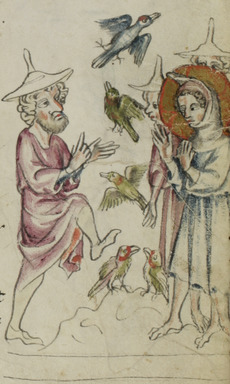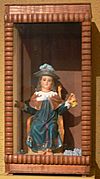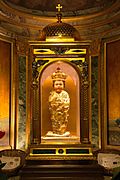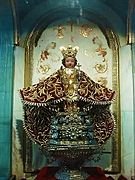Christ Child facts for kids

The Christ Child, also known as Baby Jesus or Infant Jesus, refers to Jesus Christ from when he was born until he turned 12 years old.
The four main books about Jesus' life, called the Gospels, don't tell us much about what Jesus did between being a baby and when he was 12. The only story they share from those years is when he was found teaching in the Temple.
Contents
Special Days for the Christ Child
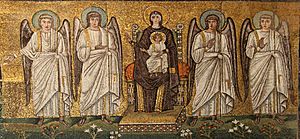
Many special days, or liturgical feasts, celebrate different parts of the Christ Child's early life. These include:
- Christmas Day (December 25), which celebrates Jesus' birth.
- The Feast of the Circumcision of Christ (January 1), celebrated by some churches.
- The Feast of the Holy Name of Jesus (January 3), which honors Jesus' name.
- The Feast of the Epiphany (January 6 or 19), celebrating the wise men visiting Jesus.
- The Feast of the Presentation of the Lord (February 2), when Jesus was presented at the Temple.
The Christ Child in Art

Artists have shown the Christ Child in paintings and sculptures since the 300s or 400s. Often, these artworks show scenes of Jesus' birth. They usually include his mother, Mary, and her husband, Joseph.
Many artworks show baby Jesus with the Virgin Mary. These are called Madonna and Child and are very common in both Eastern and Western Christian art. Other popular scenes include Jesus' circumcision, his presentation at the temple, the wise men visiting him, and the Holy Family escaping to Egypt. Scenes of Jesus as an older child are less common but do exist.
Some saints are often shown holding the Christ Child. These include Saint Joseph, Anthony of Padua, and Saint Christopher. Some Christian holy people, like Saint Teresa of Ávila and Saint Thérèse of Lisieux, have said they saw visions of Jesus as a young child.
Art During the Middle Ages
During the 1300s, the Christ Child became a very popular subject for wood sculptures in Europe.
In Spain, these sculptures were known as montañesino. This style was named after the sculptor Juan Martínez Montañés. These statues often showed the Christ Child in a special pose called contrapposto. This pose makes the knees point in opposite directions, similar to old statues of Roman Emperors.
These images were very popular among the rich families in Spain and Portugal. Later, in colonial times, statues of the Christ Child started wearing special clothes called vestments. They often held a globus cruciger (a globe with a cross), a bird (which can symbolize a soul or the Holy Spirit), or other items from their local area.
The way the Child Jesus was shown in art became most important during the Renaissance. The Holy Family (Jesus, Mary, and Joseph) was a main theme in the works of famous artists like Leonardo da Vinci.
Stories Outside the Bible
Some ancient writings, not part of the official Bible, are called Biblical apocrypha. The Infancy Gospels are a group of these writings that tell stories about Jesus' birth and early life. These stories often show Jesus having amazing powers and knowledge even when he was very young.
One common story tells how young Jesus made clay sparrows come to life. When he was told off for doing this on the Sabbath (a holy day), he made the birds fly away.
Special Devotional Images
Several famous images of the Christ Child have been honored by the Pope. These include the Bambino Gesu of Arenzano and the Santo Bambino of Aracoeli in Italy. Also, the Infant Jesus of Prague in the Czech Republic, and the Santo Niño de Cebú in the Philippines.
In the 1600s, a group of nuns in France helped people honor the "Little King of Beaune." Later, in the late 1800s, people in Madrid, Spain, began to honor the “Holy Child of Remedy.”
Music About the Christ Child
Tàladh Chrìosda (meaning "Christ Child Lullaby") is a Scottish Christmas song. A Catholic priest named Father Ranald Rankin wrote the words around 1855 for Midnight Mass. He first wrote 29 verses in Scottish Gaelic. However, the popular English version only has five verses.
The tune, Cumha Mhic Arois, comes from the Hebrides islands. It was originally sung as a protective charm for fishermen at sea. The rhythm of the song sounds like the waves of the ocean. People still sing it in the Hebrides at Midnight Mass on Christmas Eve.
Groups Honoring the Christ Child
Archconfraternity of the Holy Infancy
In 1636, a Carmelite nun named Marguerite of the Holy-Sacrament started a group called the Association of the Child Jesus. This group was in Beaune, France, and honored Jesus' early childhood. Later, the local Bishop officially approved it as the Confraternity of the Holy Infancy.
In 1639, a chapel was built in Beaune and dedicated to the Infant Jesus. A man named Gaston Jean Baptiste de Renty gave a statue to the chapel, which became known as the "Little King of Grace."
This devotion grew, and in 1661, Pope Alexander VII approved the Confraternity. Later, in 1855, Pope Pius IX made it an Archconfraternity, which is a higher level of religious group.
Christ Child Society
The Christ Child Society was started in 1885 in Washington, D.C., by Mary Virginia Merrick. It began as a small group helping children in need in the local area. Since then, more groups have been started in other cities.
Gallery
-
Santo Niño de Cebú, Philippines
See also
 In Spanish: Niño Jesús para niños
In Spanish: Niño Jesús para niños
- Child Jesus images in Mexico
- Holy Infant of Good Health
- Infant Jesus of Mechelen
- Infant Jesus of Prague
- Santo Niño (disambiguation)
- Santo Niño de Atocha
- Maria Bambina - a similar devotion to Mary as a child



